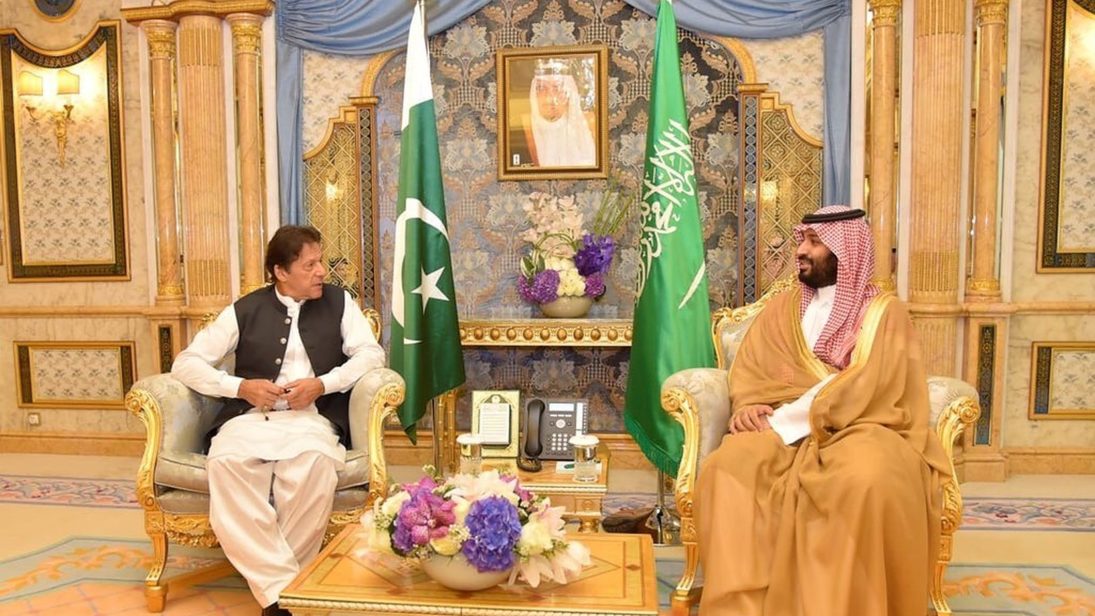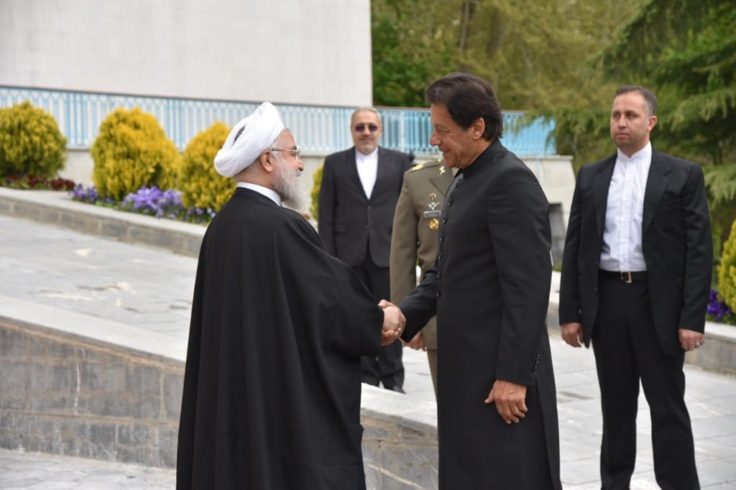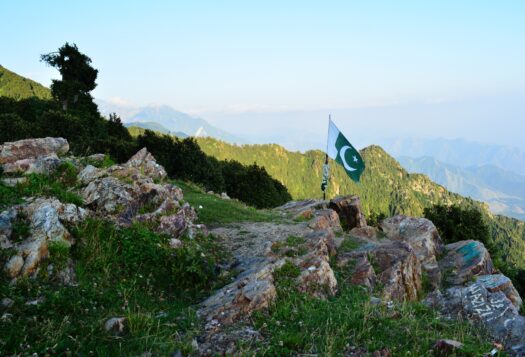
Only a month after assuming office, Imran Khan made his first overseas trip as Pakistan’s prime minister to Saudi Arabia and the United Arab Emirates (UAE). With hopes of procuring financial assistance for Pakistan’s floundering economy, the economic support offered by Saudi Arabia following the visit pointed to the success of Khan’s diplomatic efforts. However, with Pakistan’s economy still in a dire condition, exacerbated by growing interest on foreign debt, the country needs to take steps in both the short- and the long-term to move beyond its reliance on aid, and revitalize economic cooperation across multiple sectors with the Middle East.
Pakistan’s Middle East policy has largely been focused on cultural, religious, and political ties. Politically, Pakistan has tried to balance relations between Iran and Saudi Arabia while avoiding becoming a third party in various ongoing wars in the Middle East. Islamabad has mostly emphasized strategic gains and aid in its relationships with the Gulf rather than building economic linkages through trade and investment. Though Pakistan has given some importance to securing energy resources from the region, efforts to improve economic ties with the Middle East have been lackluster at best. In the short-term, Pakistan should take steps to remove hurdles in its existing economic ties to the Middle East while in the long-term, look for new areas of trade cooperation with the region that draw on Pakistan’s strengths.
Islamabad has mostly emphasized strategic gains and aid in its relationships with the Gulf rather than building economic linkages through trade and investment.
Improve the System of Remittances
The most immediate change Pakistan can make is in its system of remittances. In 2017, remittances accounted for approximately 7 percent of Pakistan’s Gross Domestic Product (GDP) or about USD $19.62 billion, while this year, they are excepted to grow to a potential USD $22 billion. A substantial portion of Pakistan’s remittances come from Gulf countries, with Saudi Arabia as the largest source. However, Pakistan’s economic income from remittances still falls short of its potential. For instance, while Pakistan’s diaspora population in Saudi Arabia is nearly the same size as India’s, they contribute fewer remittances than their Indian counterparts.
Despite the Pakistan Remittance Initiative (PRI) put in place in 2009 to make the remittance process cheaper and faster, it is still ineffective and leads to a reliance on informal channels. More could be done to reduce remittance charges, particularly on smaller transfer amounts, and to make the process of transferring funds less cumbersome. For instance, this could be done by promoting initiatives such as mobile wallets, which have addressed factors such as cost and lack of access to formal banking that have contributed to the remittances gap in Pakistan.
Revitalize Trade
Pakistan should re-energize discussions of a Free Trade Agreement (FTA) with the Gulf Cooperation Council (GCC). With an overall negative balance of trade, an FTA in the Middle East could boost Pakistan’s exports. Pakistan’s strength in agriculture exports coupled with the demand for food imports in the Middle East make an FTA beneficial for both parties.
Arid conditions and water scarcity in the Middle East make food security an ongoing concern, and Gulf countries are especially dependent on food imports – a strong export sector for Pakistan. Both Saudi Arabia and the UAE have also recently suggested they would cut back on Indian agriculture imports due to high levels of pesticides, and Saudi Arabia has also expressed concerns over India’s rice exports. Similar regulations in the European Union had already opened the market for Pakistani exporters. Plans to improve Pakistan’s agriculture sector by investing in agricultural research and improving crop yields may also make Pakistani agricultural goods more competitive in the global market. Pakistan can also capitalize on the halal food industry. At the moment, Pakistan contributes only three percent to the USD $3 trillion industry. Not limited to the Middle East countries alone, it is estimated that by 2020, the global halal food market will grow by six percent.
Besides looking to its traditional partners in the Gulf, Pakistan can expand its trade in the Middle East by revisiting other bilateral relationships. Oman, in particular, reflects Pakistan’s unexplored economic opportunities in the Middle East. Despite the fact that Oman is geographically the closest Arab nation to Pakistan and has nearly 800,000 Pakistanis working there, there is little bilateral activity between the two apart from occasional joint military exercises. The value of Pakistan’s exports to Oman stands at approximately USD $118 million, well below potential. The poultry industry, for instance, is a niche that Pakistan could foster with Oman. Presently, Oman imports around 57.5 percent of its poultry, while Pakistan produces a poultry surplus. Likewise, Oman could export energy resources to Pakistan. Thus, Oman could be a potential source of uncharted economic possibilities, representative of other unexplored areas of cooperation in Pakistan-Middle East economic relations.

Leveraging both Saudi Arabia and Iran
Pakistan should do more to engage with both Saudi Arabia and Iran economically, without getting drawn into a tussle between the two regional rivals. Maintaining economic relations with Saudi Arabia, the largest Arab economy, is crucial for Pakistan, particularly given the Kingdom’s past financial support and recent investment promises. But on the other hand, Iran’s geographical proximity makes it a natural trade and economic partner.
Despite being Pakistan’s main ally in the region, Pakistan and Saudi Arabia have relatively weak trade relations. For instance, Pakistan-Saudi Arabia trade figures are only a fraction of India-Saudi Arabia trade. While Pakistan’s imports from Saudi Arabia amounted to USD $3.24 billion last year, its exports were a mere USD $316 million. The trade figures are reflective of the urgent need for a detailed study of the Saudi market in order to identify gaps that Pakistan can fill. Niches such as export of sports items could be captured within the Saudi market given that their Vision 2030 places a special emphasis on sport promotion. This is just one potential avenue of cooperation as Saudi Arabia moves forward with its major investment plan.
An economic partnership with Iran should be prioritized over a more strategic partnership for two reasons: first, a focus on a strategic alliance would be susceptible to backlash by the Saudis and consequently, a potential sectarian backlash within Pakistan. Second, an economic relationship with Iran has potential not only in terms of domestic gains but also regional benefits. An example is the Iran-Pakistan (IP) gas pipeline, which can help aid development of both Balochistan and the wider South Asian region as well. Although the project was recently delayed by U.S. sanctions, recent signs indicate Iran and Pakistan may be moving ahead on the pipeline.
Taking steps to revitalize and create bilateral mechanisms for trade and communication can open doors for greater economic partnership between [Pakistan and Iran] in the long-term.
In recent years, delegations from Pakistan and Iran have discussed boosting trade to USD $5 billion, which, if achieved, would have long-term benefits for both countries. The two countries could also pursue a system of barter trade, as discussed in June 2019. This cashless system could include agricultural products from Pakistan and energy resources from Iran.
However, pursuing a more robust trade strategy with Iran does carry certain risks for Pakistan’s other foreign relations, particularly taking into consideration the GCC’s recent significant financial support to Pakistan, and Pakistan’s warming relationship with the United States. Additionally, a challenge in the short-term will be reworking the banking system as Pakistani exporters have faced difficulties finding local banks that are willing to engage with the exporters’ Iranian counterparts. But Pakistan should weigh these risks against its own national interests. One way to balance both would be to increase economic cooperation with Iran very gradually through steps such as road, rail, and air links while continuing to strengthening its relationship with the GCC. Taking steps to revitalize and create bilateral mechanisms for trade and communication can open doors for greater economic partnership between the neighboring countries in the long-term.
Conclusion
It is evident that Pakistan is not fully pursuing the economic potential of its relationships in the Middle East. Securing financial aid alone does not represent success in Pakistan-Middle East economic relations. By seeking new areas of economic engagement, revitalizing past economic initiatives, and looking to its own export strengths for areas of potential cooperation, Islamabad can build more sustainable economic ties in the Middle East. As Pakistan works to calm its economy’s turbulent waters, the Middle East remains an important partner with untapped economic potential.
***


